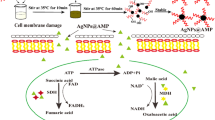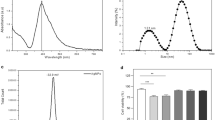Abstract
Antimicrobial resistance to traditional antibiotics leads to a serious concern for medical care owing to ineffective antibiotic therapies. This study focused on the preparation of silver nanocomposites (AgNPs@Tob&PAGA) by modifying AgNPs with tobramycin (Tob) and carbohydrate polymer of poly(2-(acrylamido) glucopyranose) (PAGA). The enhanced antibacterial activities of nanocomposites against common pathogens of Escherichia coli (E. coli) and Staphylococcus aureus (S. aureus) were explored. The introduction of PAGA onto silver nanocomposites improved both citocompatibility and antibacterial activity. Compared with nude Tob, AgNPs@Tob&PAGA showed more fascinating antimicrobial effect against E. coli and S. aureus with about 20-fold increase in the antibacterial activity, simultaneously no detectable resistance was observed. Consequently, the silver nanocomposite as an antimicrobial agent presents promising prospects in the treatment of bacterial infections caused by antimicrobial resistant bacteria.









Similar content being viewed by others
References
Franci G, Falanga A, Galdiero S, Palomba L, Rai M, Morelli G et al. Silver nanoparticles as potential antibacterial agents. Molecules. 2015;20:8856–74.
Naik MM, Prabhu MS, Samant SN, Naik PM, Shirodkar S. Synergistic action of silver nanoparticles synthesized from silver resistant estuarine Pseudomonas aeruginosa strain Sn5 with antibiotics against antibiotic resistant bacterial human pathogens. Thalassas. 2017;33:73–80.
Panacek A, Smekalova M, Vecerova R, Bogdanova K, Roderova M, Kolar M et al. Silver nanoparticles strongly enhance and restore bactericidal activity of inactive antibiotics against multiresistant Enterobacteriaceae. Colloid Surf B. 2016;142:392–9.
Nasiri A, Gharebagh RA, Nojoumi SA, Akbarizadeh M, Harirchi S, Arefnezhad M et al. Evaluation of the antimicrobial activity of silver nanoparticles on antibiotic-resistant Pseudomonas aeruginosa. Int J Basic Sci Med. 2016;1:25–8.
Xin Q, Shah H, Nawaz A, Xie WJ, Akram MZ, Batool A, et al. Antibacterial carbon-based nanomaterials. Adv. Mater. 2018;1804838–52. https://doi.org/10.1002/adma.201804838.
Mukherjee S, Chowdhury D, Kotcherlakota R, Patra S, Vinothkumar B, Bhadra MP et al. Potential theranostics application of bio-synthesized silver nanoparticles (4-in-1 system). Theranostics. 2014;4:316–35.
Hajipour MJ, Fromm KM, Ashkarran AA, Jimenez de Aberasturi D, de Larramendi IR, Rojo T et al. Antibacterial properties of nanoparticles. Trends Biotechnol. 2012;30:499–511.
Rai MK, Deshmukh SD, Ingle AP, Gade AK. Silver nanoparticles: the powerful nanoweapon against multidrug-resistant bacteria. J Appl Microbiol. 2012;112:841–52.
Marambio-Jones C, Hoek EMV. A review of the antibacterial effects of silver nanomaterials and potential implications for human health and the environment. J Nanopart Res. 2010;12:1531–51.
Stensberg MC, Wei Q, McLamore ES, Porterfield DM, Wei A, Sepulveda MS. Toxicological studies on silver nanoparticles: challenges and opportunities in assessment, monitoring and imaging. Nanomedicine. 2011;6:879–98.
Catauro M, Raucci MG, De Gaetano F, Marotta A. Antibacterial and bioactive silver-containing na2o x cao x 2sio2 glass prepared by sol–gel method. J Mater Sci Mater Med. 2004;15:831–7.
Kumar CG, Sujitha P. Green synthesis of kocuran-functionalized silver glyconanoparticles for use as antibiofilm coatings on silicone urethral catheters. Nanotechnology. 2014;25:325101.
Russell D, Hugo WB. Antimicrobial activity and action of silver. Prog Med Chem. 1994;31:351–70.
Lara HH, Garza-Trevino EN, Ixtepan-Turrent L, Singh DK. Silver nanoparticles are broad-spectrum bactericidal and virucidal compounds. J Nanobiotechnol. 2011;9:30.
Dallas P, Sharma VK, Zboril R. Silver polymeric nanocomposites as advanced antimicrobial agents: classification, synthetic paths, applications, and perspectives. Adv Colloid Inter Sci. 2011;166:119–35.
Kumar A, Vemula PK, Ajayan PM, John G. Silver-nanoparticle-embedded antimicrobial paints based on vegetable oil. Nat Mater. 2008;7:236–41.
Smekalova M, Aragon V, Panacek A, Prucek R, Zboril R, Kvitek L. Enhanced antibacterial effect of antibiotics in combination with silver nanoparticles against animal pathogens. Vet J. 2016;209:174–9.
Walter F, Vicens Q, Westhof E. Aminoglycoside–RNA interactions. Curr Opin Chem Biol. 1999;3:694–704.
Kim J, Pitts B, Stewart PS, Camper A, Yoon J. Comparison of the antimicrobial effects of chlorine, silver ion, and tobramycin on biofilm. Antimicrob Agents Chem. 2008;52:1446–53.
Lee H-S, Dastgheyb SS, Hickok NJ, Eckmann DM, Composto RJ. Targeted release of tobramycin from a ph-responsive grafted bilayer challenged with S. aureus. Biomacromolecules. 2015;16:650–9.
Du J, Bandara HMHN DuP, Huang H, Hoang K, Nguyen D, Mogarala SV et al. Improved biofilm antimicrobial activity of polyethylene glycol conjugated tobramycin compared to tobramycin in pseudomonas aeruginosa biofilms. Mol Pharm. 2015;12:1544–53.
Domalaon R, Yang X, Lyu Y, Zhanel GG, Schweizer F. Polymyxin B-3-tobramycin hybrids with pseudomonas aeruginosa-selective antibacterial activity and strong potentiation of rifampicin, minocycline, and vancomycin. ACS Infect Dis. 2017;3:941–54.
Berkov-Zrihen Y, Green KD, Labby KJ, Feldman M, Garneau-Tsodikova S, Fridman M. Synthesis and evaluation of hetero- and homodimers of ribosome-targeting antibiotics: antimicrobial activity, in vitro inhibition of translation, and drug resistance. J Med Chem. 2013;56:5613–25.
Lyu Y, Yang X, Goswami S, Gorityala BK, Idowu T, Domalaon R et al. Amphiphilic tobramycin-lysine conjugates sensitize multidrug resistant gram-negative bacteria to rifampicin and minocycline. J Med Chem. 2017;60:3684–702.
Helal HS, El-Din TAS, Ali AE, Hamouda HH, Zedan H. Tobramycin-silver nanocomposite: a new trend of antimicrobials against resistant strains. J Pharm Bio Sci. 2014;9:54–61.
Habash MB, Goodyear MC, Park AJ, Surette MD, Vis EC, Harris RJ et al. Potentiation of tobramycin by silver nanoparticles against Pseudomonas aeruginosa biofilms. Antimicrob Agents Chem. 2017;61:AAC. 00415–17.
Guo QQ, Zhao Y, Dai XM, Zhang TQ, Yu YJ, Zhang XG et al. Functional silver nanocomposites as broad-spectrum antimicrobial and biofilm-disrupting agents. ACS Appl Mater Inter. 2017;9:16834–47.
Panacek A, Kvitek L, Prucek R, Kolar M, Vecerova R, Pizurova N et al. Silver colloid nanoparticles: synthesis, characterization, and their antibacterial activity. J Phys Chem B. 2006;110:16248–53.
Xue Z, Sendamangalam VR, Gruden CL, Seo Y. Multiple roles of extracellular polymeric substances on resistance of biofilm and detached clusters. Environ Sci Technol. 2012;46:13212–19.
Ting SRS, Min EH, Zetterlund PB, Stenzel MH. Controlled/living ab initio emulsion polymerization via a glucose raftstab: degradable cross-linked glyco-particles for concanavalin a/fimh conjugations to cluster E. coli bacteria. Macromolecules. 2010;43:5211–21.
Guo QQ, Zhang TQ, An JX, Wu ZM, Zhao Y, Dai XM et al. Block versus random amphiphilic glycopolymer nanopaticles as glucose-responsive vehicles. Biomacromolecules. 2015;16:3345–56.
Taglietti A, Arciola CR, D’Agostino A, Dacrro G, Montanaro L, Campoccia D et al. Antibiofilm activity of a monolayer of silver nanoparticles anchored to an amino-silanized glass surface. Biomaterials. 2014;35:1779–88.
Chernousova S, Epple M. Silver as antibacterial agent: ion, nanoparticle, and metal. Angew Chem Int Ed. 2013;52:1636–53.
Gorham JM, Mac Cuspie RI, Klein KL, Fairbrother DH, Holbrook RD. UV-induced photochemical transformations of citrate capped silver nanoparticle suspensions. J Nanopart Res. 2012;14:1139–55.
Veerapandian M, Lim SK, Nam HM, Kuppannan G, Yun KS. Glucosamine-functionalized silver glyconanoparticles: characterization and antibacterial activity. Anal Bioanal Chem. 2010;398:867–76.
Lyu YF, Domalaon R, Yang X, Schweizer F. Amphiphilic lysine conjugated to tobramycin synergizes legacy antibiotics against wild-type and multidrug-resistant Pseudomonas aeruginosa. Biopolymers. 2017;23091–7. https://doi.org/10.1002/bip.23091.
Laycock PA, Cooper JJ, Howlin RP, Delury C, Aiken S, Stoodley P. In vitro efficacy of antibiotics released from calcium sulfate bone void filler beads. Materials. 2018;11:2265–79.
Cheer SM, Waugh J, Noble S. Inhaled tobramycin (TOBI): a review of its use in the management of Pseudomonas aeruginosa infections in patients with cystic fibrosis. Drugs. 2003;63:2501–20.
Liu HQ, Wang XX, Wu YZ, Hou J, Zhang SY, Zhou N et al. Toxicity responses of different organs of zebrafish (Danio rerio) to silver nanoparticles with different particle sizes and surface coatings. Environ Pollut. 2019;246:414–22.
Brown D. Antibiotic resistance breakers: can repurposed drugs fill the antibiotic discovery void? Nat Rev Drug Discov. 2015;14:821–32.
Wright GD. Q&A: antibiotic resistance: where does it come from and what can we do about it? BMC Biol. 2010;8:123–8.
Panáček A, Smékalová M, Kilianová M, Prucek R, Bogdanová K, Večeřová R et al. Strong and nonspecific synergistic antibacterial efficiency of antibiotics combined with silver nanoparticles at very low concentrations showing no cytotoxic effect. Molecules. 2016;21:26–42.
Beer C, Foldbjerg R, Hayashi Y, Sutherland DS, Autrup H. Toxicity of silver nanoparticles-nanoparticle or silver ion? Toxicol Lett. 2012;208:286–92.
Lerner AM, Reyes MP, Cone LA, Blair DC, Jansen W, Wright GE et al. Randomised, controlled trial of the comparative efficacy, auditory toxicity, and nephrotoxicity of tobramycin and netilmicin. Lancet. 1983;1:1123–6.
Acknowledgements
This work was supported by Doctoral Foundation of Guizhou Medical University (Grant no. JY2017-28), the Science and Technology Department of Guizhou Province, Guizhou Branch of Talent Gund (Grant no. [2017]5718), the Guizhou Provincial Department of Education Youth Science and Technology Talent Development Project (No. [2018]150), the Innovated Team of the Education Department of Guizhou Province (No. 2014-31), the High-level Innovation Talents (No. 2015-4029), the Innovation Team of Guizhou Province [No. 2015-4025], and International Science & Technology Cooperation Base [No. (2017)5802].
Author information
Authors and Affiliations
Corresponding authors
Ethics declarations
Conflict of interest
The authors declare that they have no conflict of interest.
Additional information
Publisher’s note: Springer Nature remains neutral with regard to jurisdictional claims in published maps and institutional affiliations.
Rights and permissions
About this article
Cite this article
Guo, Q., Lan, T., Chen, Y. et al. Enhanced of antibacterial activity of antibiotic-functionalized silver nanocomposites with good biocompatibility. J Mater Sci: Mater Med 30, 34 (2019). https://doi.org/10.1007/s10856-019-6236-8
Received:
Accepted:
Published:
DOI: https://doi.org/10.1007/s10856-019-6236-8




